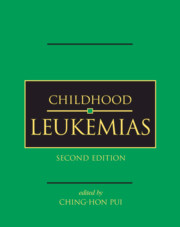Book contents
- Frontmatter
- Contents
- List of contributors
- Preface
- Part I History and general issues
- Part II Cell biology and pathobiology
- 4 Anatomy and physiology of hematopoiesis
- 5 Hematopoietic growth factors
- 6 Signal transduction in the regulation of hematopoiesis
- 7 Immunophenotyping
- 8 Immunoglobulin and T-cell receptor gene rearrangements
- 9 Cytogenetics of acute leukemias
- 10 Molecular genetics of acute lymphoblastic leukemia
- 11 Molecular genetics of acute myeloid leukemia
- 12 Apoptosis and chemoresistance
- 13 Heritable predispositions to childhood hematologic malignancies
- Part III Evaluation and treatment
- Part IV Complications and supportive care
- Index
- Plate Section between pages 400 and 401
- References
7 - Immunophenotyping
from Part II - Cell biology and pathobiology
Published online by Cambridge University Press: 01 July 2010
- Frontmatter
- Contents
- List of contributors
- Preface
- Part I History and general issues
- Part II Cell biology and pathobiology
- 4 Anatomy and physiology of hematopoiesis
- 5 Hematopoietic growth factors
- 6 Signal transduction in the regulation of hematopoiesis
- 7 Immunophenotyping
- 8 Immunoglobulin and T-cell receptor gene rearrangements
- 9 Cytogenetics of acute leukemias
- 10 Molecular genetics of acute lymphoblastic leukemia
- 11 Molecular genetics of acute myeloid leukemia
- 12 Apoptosis and chemoresistance
- 13 Heritable predispositions to childhood hematologic malignancies
- Part III Evaluation and treatment
- Part IV Complications and supportive care
- Index
- Plate Section between pages 400 and 401
- References
Summary
Introduction
The diagnosis and treatment of childhood leukemia rest on the recognition of a leukemic cell population and its cell lineage and, sometimes, the stage of maturation. The presence in leukemic blasts of myeloperoxidase, Auer rods, or monocyte-associated esterases readily identify most cases of acute myeloid leukemia (AML). By contrast, the leukemic blasts of acute lymphoblastic leukemia (ALL) have no unique morphologic or cytochemical features. Malignant megakaryoblasts also lack defining cytologic and cytochemical features and may be mistaken for ALL. Although rare in children, chronic lymphoid malignancies, such as large granular lymphocyte leukemia or HTLV-1-associated leukemia can be confused with reactive lymphocytosis or acute leukemia. The prognosis and therapy for ALL, AML, and chronic leukemias differ greatly; thus, it is crucial to document the lineage and stage of maturation of leukemias. In the absence of diagnostic morphologic features, accurate diagnosis requires contemporary immunologic and molecular analyses. Immunologic testing, or immunophenotyping, is an essential component of the diagnostic work-up by confirming or establishing the leukemic cell lineage, stage of differentiation, and sometimes clonality. The results of immunophenotyping also correlate with cytogenetic abnormalities, facilitate minimal residual disease studies, and provide prognostic information.
The earliest immunophenotyping studies of leukemias were performed with polyclonal antisera produced to T lymphocytes, immunoglobulin (Ig) heavy and light chains, the common acute lymphoblastic leukemia antigen (CALLA), the minor histocompatibility antigen HLA-DR, and terminal deoxynucleotidyl transferase (TDT).
- Type
- Chapter
- Information
- Childhood Leukemias , pp. 150 - 209Publisher: Cambridge University PressPrint publication year: 2006
References
- 2
- Cited by



